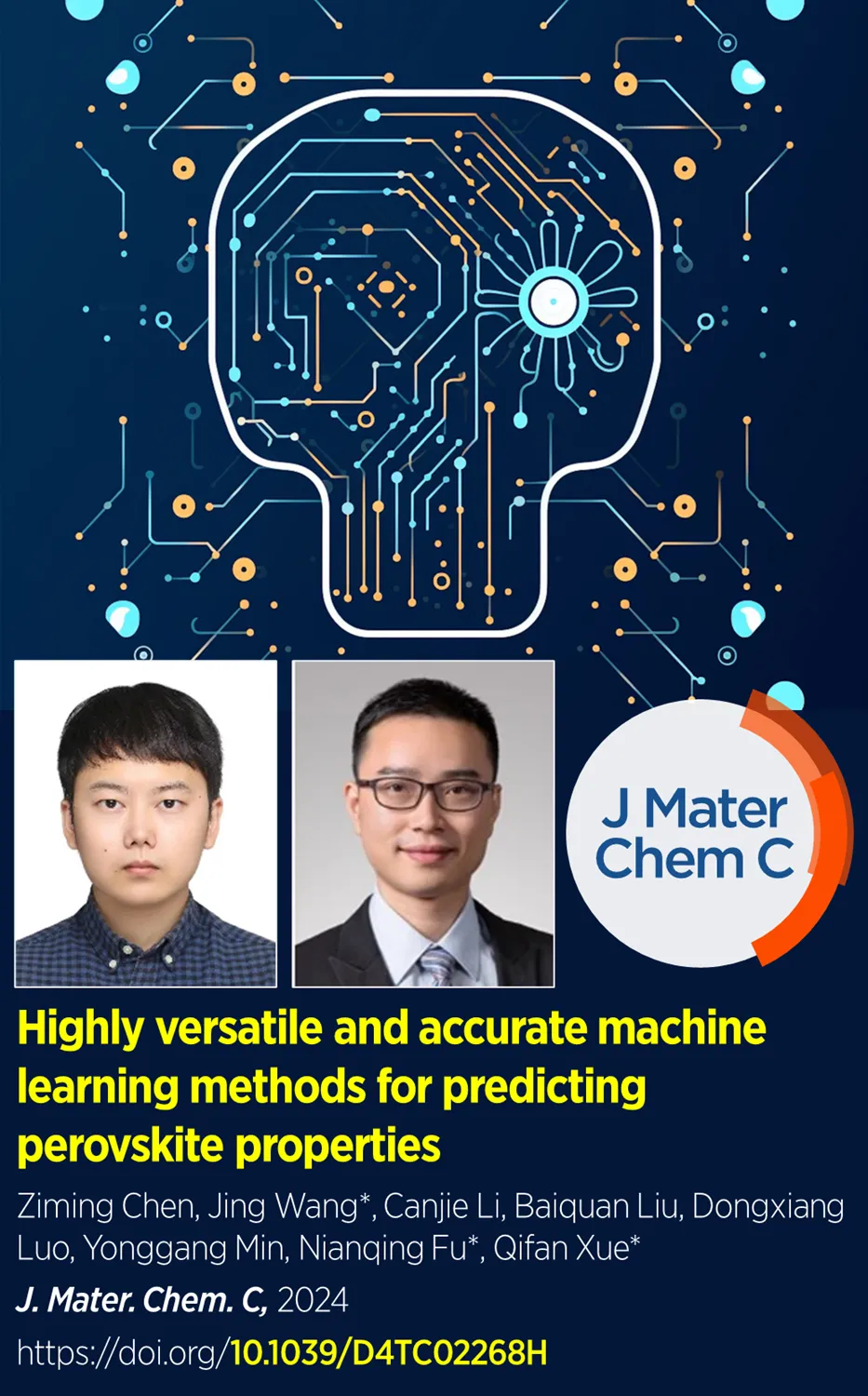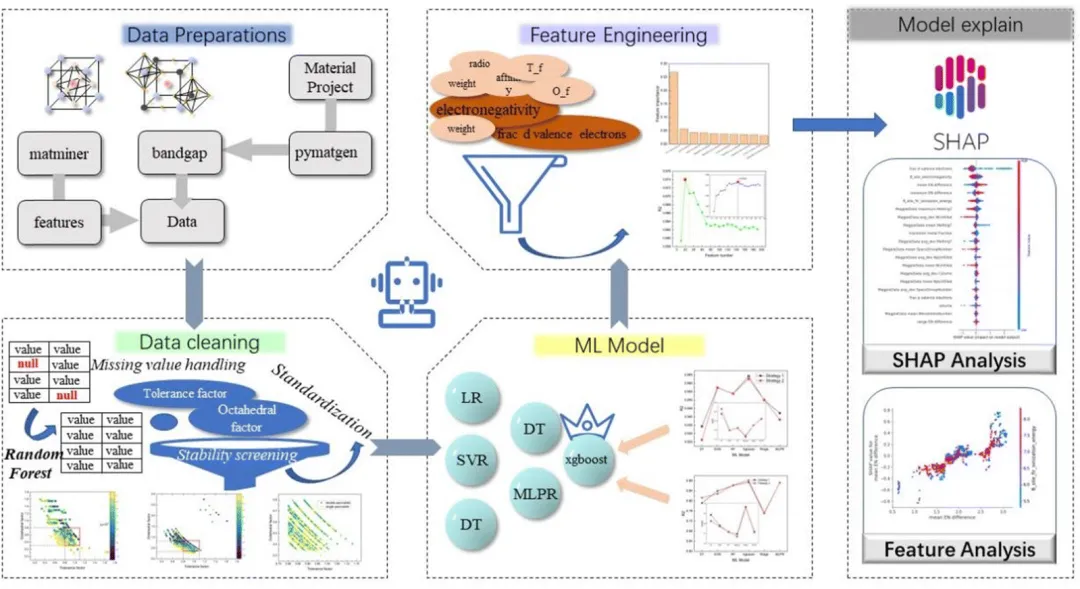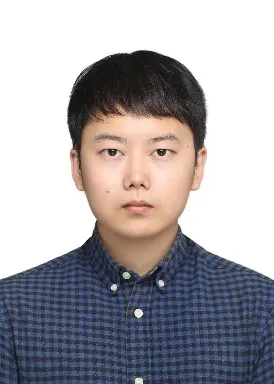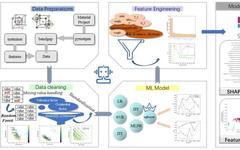

Research Background
The bandgap is one of the most important fundamental properties of perovskite materials in photovoltaic applications. To obtain the bandgap of unknown materials, it can be estimated through experiments like UV-Vis diffuse reflectance spectroscopy or photoluminescence (PL) and X-ray photoelectron spectroscopy (XPS). These experiments require huge and expensive equipment. Choosing to use DFT calculations is a more cost-effective and faster method; however, using Local Density Approximation (LDA) or Generalized Gradient Approximation (GGA) methods often results in underestimating the calculated bandgap. The GW algorithm can accurately calculate the bandgap of materials, but it is correspondingly more expensive and time-consuming. In summary, an accurate bandgap cannot be achieved through a simple method, thus bandgap estimation remains a significant challenge today.
Article Introduction
The team led by Xue Qifan at the State Key Laboratory of Luminescent Materials and Devices, South China University of Technology, proposed a machine learning method that can quickly predict the bandgap of perovskite materials within an acceptable error range, significantly accelerating the research on light-absorbing materials.
A database containing 3720 ABX3-type perovskites and 2660 A2B(I)B(II)X6-type double perovskites was used to train the model, including their bandgap and formation energy information. All data was sourced from the Materials Project dataset. Nearly 300 descriptors were generated using the Matminer Python package. After processing missing values, stability screening, and normalization, the data was fed into six machine learning models including XGBoost for 10-fold cross-validation. The most effective model, XGBoost, showed a significant R² coefficient (0.873) and a root mean square error (RMSE) of 0.5868 eV. Finally, SHAP (SHapley Additive exPlanation) analysis was conducted to identify the most influential descriptors.

- Figure 1. The complete workflow of this work, including data collection; data cleaning (stability screening, handling missing values, and data preprocessing, etc.); model training (linear regression, support vector regression, decision tree, random forest, multilayer perceptron, and extreme gradient boosting); feature engineering optimization and SHAP interpretability analysis.
The results of this work indicate that higher formation energy, a considerable proportion of transition metals, and a large number of d-orbital valence electrons contribute to the formation of narrow bandgap perovskites. Conversely, a large number of f-orbital electrons and differences in electronegativity between elements often lead to wide bandgap perovskites. This comprehensive analysis not only provides insights into the fundamental factors affecting the bandgap of perovskite materials but also emphasizes the potential of machine learning in accelerating materials research.This achievement was published in the Royal Society of Chemistry journal Journal of Materials Chemistry C under the title “Highly versatile and accurate machine learning methods for predicting perovskite properties” and was selected as a hot article.

Paper Information
-
Highly versatile and accurate machine learning methods for predicting perovskite properties
Ziming Chen, Jing Wang*, Canjie Li, Baiquan Liu, Dongxiang Luo, Yonggang Min, Nianqing Fu*, Qifan Xue*(Xue Qifan, South China University of Technology)
J. Mater. Chem. C, 2024https://doi.org/10.1039/D4TC02268H
Author Information
 Ziming Chen Master’s StudentSouth China University of Technology
Ziming Chen Master’s StudentSouth China University of Technology
First author of this article, a master’s student currently studying at the School of Materials Science and Engineering/State Key Laboratory of Luminescent Materials and Devices at South China University of Technology, supervised by Xue Qifan. His main research direction is the comprehensive study of perovskite solar cells and machine learning.
 Xue Qifan Associate ResearcherSouth China University of TechnologyCorresponding author of this article, recipient of the Guangdong Provincial Outstanding Youth Fund, his research focuses on organic and perovskite optoelectronic materials and devices, including new material development, interface modification, new devices, device physics, and process improvement. He has published over 80 SCI papers, including more than 50 as the first author or corresponding author, in top-tier journals such as Joule, Adv. Mater., Angew. Chem. Int. Ed., Energy Environ. Sci., Adv. Energy Mater., Adv. Funct. Mater., Sci. China Chem., with a total of over 7800 citations, an H-index of 41. He has led three projects funded by the Ministry of Science and Technology and the National Natural Science Foundation, as well as seven provincial and municipal projects. He was selected as a TCL Young Scholar and a Rising Scientist in Energy Materials in 2022, and has won several awards including the First Prize in the National Innovation Competition, the DAAD Technology Award in Germany, and the GE Technology Innovation Award in the USA. He has guided his team to win the Silver Award in the 5th China “Internet+” College Students Innovation and Entrepreneurship Competition in Guangdong Province, the First Prize in the 9th Guangdong University Students Material Innovation Competition, and the Gold Award in the 12th “Challenge Cup” Guangdong University Students Entrepreneurship Competition. He serves as the Secretary-General of the International Society of Energy Photonics, a member of the standard working group for perovskite photovoltaic cells, a member of the Youth Working Committee of the Guangdong Province Materials Research Society, and an associate editor for Frontiers in Chemistry, and a youth editorial board member for journals such as Journal of Energy Chemistry, Nano-Micro Letters, Materials Research Letters, Advanced Powder Materials.Source: RSC
Xue Qifan Associate ResearcherSouth China University of TechnologyCorresponding author of this article, recipient of the Guangdong Provincial Outstanding Youth Fund, his research focuses on organic and perovskite optoelectronic materials and devices, including new material development, interface modification, new devices, device physics, and process improvement. He has published over 80 SCI papers, including more than 50 as the first author or corresponding author, in top-tier journals such as Joule, Adv. Mater., Angew. Chem. Int. Ed., Energy Environ. Sci., Adv. Energy Mater., Adv. Funct. Mater., Sci. China Chem., with a total of over 7800 citations, an H-index of 41. He has led three projects funded by the Ministry of Science and Technology and the National Natural Science Foundation, as well as seven provincial and municipal projects. He was selected as a TCL Young Scholar and a Rising Scientist in Energy Materials in 2022, and has won several awards including the First Prize in the National Innovation Competition, the DAAD Technology Award in Germany, and the GE Technology Innovation Award in the USA. He has guided his team to win the Silver Award in the 5th China “Internet+” College Students Innovation and Entrepreneurship Competition in Guangdong Province, the First Prize in the 9th Guangdong University Students Material Innovation Competition, and the Gold Award in the 12th “Challenge Cup” Guangdong University Students Entrepreneurship Competition. He serves as the Secretary-General of the International Society of Energy Photonics, a member of the standard working group for perovskite photovoltaic cells, a member of the Youth Working Committee of the Guangdong Province Materials Research Society, and an associate editor for Frontiers in Chemistry, and a youth editorial board member for journals such as Journal of Energy Chemistry, Nano-Micro Letters, Materials Research Letters, Advanced Powder Materials.Source: RSC
For submissions, reprints, and collaborations, please contact WeChat:MatResFron001

Welcome to leave comments and share your views.Support the authors by clicking the lower right corner “Like”” and “Looking”↓↓↓
